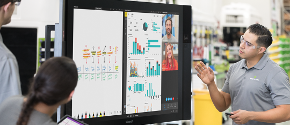
Drive collaboration in your modern workplace
The amount of time employees spend engaged in collaborative work–such as meetings, phone calls, or answering emails-has increased about 50 percent in the last two decades, taking a huge chunk out of employees time – 80% to be precise.
With a mix of generations in the workforce, along comes a set of different expectations and ways of collaborating. Generation Z, for example, are more likely to reach out quickly via chat, over email or phone.
We did a survey on preferred forms of communication and found that whatever the generation, when it comes down to it, everyone greatly prefers in-person meetings over any other form of communication.
As companies grow to be multilocational, teams are becoming cross-functional and with the advent of remote and flexible working, it can be harder logistically, cost-wise, or time-wise to have those much needed in-person meetings to foster collaboration.
Therefore, the tools we use to drive collaboration are becoming more and more vital. Of course, meetings have been happening over the phone via conference lines for many years, but these can be clunky and unproductive – especially as you must collaborate straight after again on any teamwork that comes out of it.
A modern workforce
Thankfully, with digital transformation, our traditional tools are being pushed into the modern workplace and are purposely created to easily increase collaboration, while staying productive and engaged. This includes using tools such as Skype for Business which allows teams to stay in touch, wherever they are.
“We have two and a half thousand employees across the region and we needed to find a better way of working in order to enable collaboration,” says Daniel Hudson, Application Support Consultant at Wessex Water.
Wessex Water uses Skype for Business alongside Surface Hubs to increase their productivity and reduce expenses.
“We have a team of developers that are based in Kuala Lumpur in Malaysia and some of those people are helping us to develop power apps on the Office 365 platform,” says Hudson. “We’ve been using the whiteboard extensively to collaborate on ideas, design the apps in person, and also to share the workflows between the teams. Obviously, it’s not the kind of meeting where we can fly someone over every day. So, without this I think that the team may not have worked so well together.”
Sarah Coombs, Head of Business Services agrees. “Many of our employees are based from offices, sites, depos, and treatment works that are nowhere near our operation centre in Bath. So, travelling to and from meetings has a significant cost to us as a company,” she says. “We also have the health and wellbeing of our staff to consider. The Surface Hubs give them the same meeting experience as if they were in the same room.”
They wanted to achieve a full return on their investment within three years. They believe they are well ahead of their target and are already seeing savings through reduced expenses, increased productivity, and even an environmental benefit through a reduction in travel.
Three also use Skype for Business along with other collaborative tools, such as Microsoft Teams. Since introducing these tools into their business, video calls have increased on average from 2800 to 3800 a month.
“The real advantage of Microsoft Teams is that you’re more productive because you don’t have to constantly switch between productivity apps,” says Gary Walker, Head of People Digital Tools at Three. “With Microsoft Teams, it’s contextually evident when to use the different Office 365 services—Skype for Business Online to start a meeting, OneNote to organise meeting minutes, and SharePoint Online or Microsoft OneDrive for Business to save your documents.”
Real-time results
Not only can these tools let teams from all over the UK and the world connect, it can offer the ability for teams to meet up and work on results quickly and efficiently.
“We can now Skype our ground crews during an incident so that the management team can see exactly what’s going on in real time. This provides them with the right information at the right time, which is key in an emergency,” says Coombs.
For Three, it’s not only more efficient, but it also lets remote workers feel more included and therefore more empowered to contribute more to the company.
“It’s critical that our remote employees join the conversation, so nothing slows us down,” says Gary Walker, Head of People Digital Tools at Three.
Find out more
Discover how to drive creativity in a modern workplace
Find out how to empower your organisation through teamwork and collaboration




